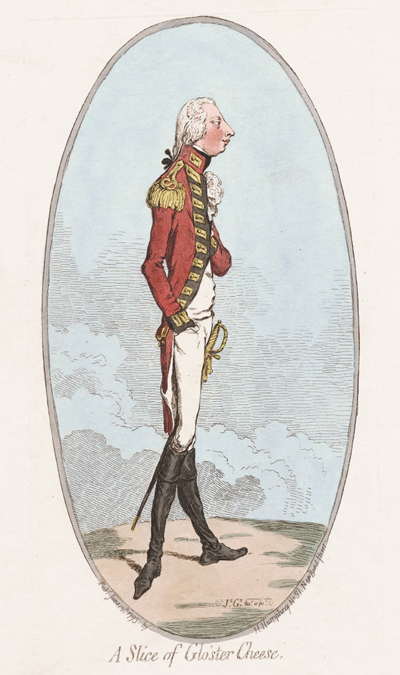A Slice of Glo'ster Cheese
Building on the tradition that began with Ghezzi and continued in England with the Darly Macaroni prints, Gillray here creates a portrait of the 19 year old Prince William Frederick, the son of the Duke of Gloucester and Edinburgh, and nephew to George III. Like the caricatures of Darly, the print shows a full-length profile of the Prince with a title that alludes to but does not explicitly reveal the identity of the sitter.

© Lewis Walpole Library, Yale University
What is different from those early prints, however, is the much greater refinement in technique that Gillray brings to his portraiture by 1795—the delicacy with which he creates the Prince's hair and lace cravat, the convincing texture of the uniform, and the wonderfully supple leather boots. The figure is exaggerated—in this case impossibly thin—but the sophistication of the technique, the more than blank background, and the portrait oval border all suggest that this is not only or not simply a portrait caricature, but the caricature of a "serious" portrait.
The portrait may have been prompted by the young Prince's public appearance at the King's 57th birthday party on the 4th of June, 1795, and subsequent newspaper reports of his movements as a precocious Colonel of the 115th regiment. The June 22 1795 LLoyd's Evening Post, for instance, reported that
It is said that Prince William is to have the command of the camp about to be formed in the neighborhood of Newcastle. His Highness's regiment (the 115th) are to form a part of the intended encampment, and are now on their march to Newcastle.
A few days later, he is reported to have arrived in Newcastle and then Edinburgh, visiting the Castle, the College, the Parliament House, etc.
Whatever the reason, Gillray must have found the tall and slim figure of the young Prince a welcome and useful contrast to the almost invariably large profiles of the other members of the Hanoverian family. He used the a variant of this caricature in The Bridal Night (1797) and again in Patern Staff. Weymouth (1797).
The "Slice" in the title derives from a nickname the Prince acquired as the (slim) son of the larger (Duke of) Gloucester, used especially by his cousins, the sons and daughters of King George. He is said to have early fallen in love with Princess Mary, proposing to her numerous times over the years. She finally accepted him in 1816 when they were both forty.
Sources and Reading
- Commentary from the British Museum on A Slice of Glo'ster Cheese
- "Prince William Frederick, Duke of Gloucester and Edinburgh," Wikipedia
- Janice Hadlow, A Royal Experiment, 2014, pp. 586 - 589.
- Thomas Wright and R.H. Evans, Historical and Descriptive Account of the Caricatures of James Gillray #407
Comments & Corrections
NOTE: Comments and/or corrections are always appreciated. To make that easier, I have included a form below that you can use. I promise never to share any of the info provided without your express permission.